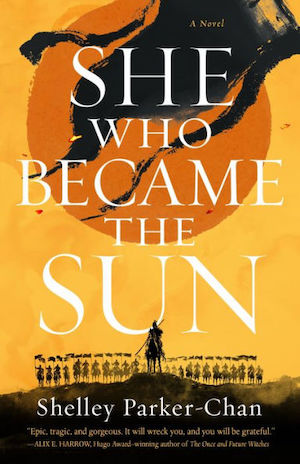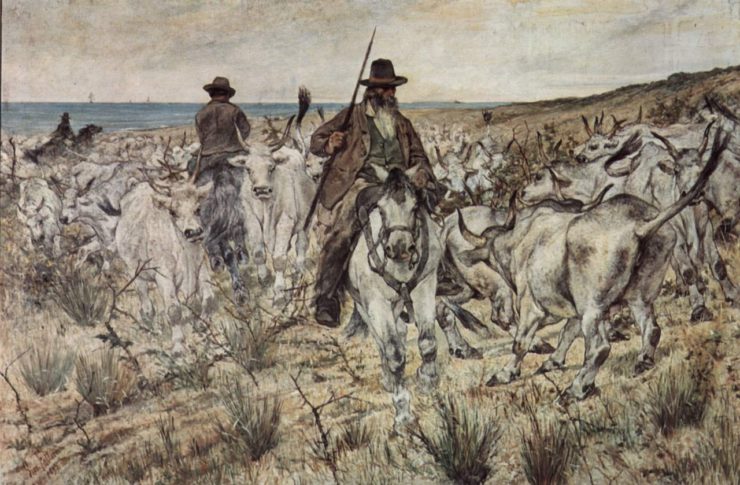It’s question time again for SFF Equines, and we have another good one:
Is cow chasing a matter solely of training, or do some breeds come with it wired, as border collies seem to be wired to herd (small humans, according to report, if there’s nothing better to organize)?
Also ducks, geese, waves, clouds, and anything else that in some way resembles a sheep. Indeed: certain dog breeds will absolutely do what they were bred to do. A border collie will herd, a hound will hunt, a husky will pull. It’s built in.
The same applies to certain breeds of horses.
They’ve been selected over centuries and millennia for specific traits. In the case of stock breeds, notably the American Quarter Horse, one of the things they will do willingly and often is herd cows. The epitome of this for me is the cutting horse. That’s a horse who competes to select specific individuals from a herd of cattle and move them to a particular part of the arena. It’s a useful skill on a working ranch, and the more into it the horse is, the more efficiently the job will get done.
Cutting horses are fascinating to watch. The rider is steering the horse minimally, past the first few moments when they indicate to the horse which cow or cows needs to be moved. The rider holds on to the saddle horn, and the reins are loose. The horse gets down, remarkably like a collie herding a sheep, and moves that cow.
The ideal cutting horse is relatively small, compact, agile and quick, and it’s often a mare. Someone told me once, “She might even bite the cow if it doesn’t do what she says.” She’s smart and confident. She takes no crap from the cow.
That’s built in, like running for a racehorse. It’s not just what the horse does, it’s what she is.
Way back in the day, when I first moved to the American Southwest, I also bought my first Lipizzan. To the Western eye she looked like a nice little not-quite-Quarter Horse, maybe with some Arab in her (actually that part was true), but something was a bit different. Shortly after she arrived at the large and eclectic boarding facility, a grizzled old cowpoke type eyed her up and down. After a minute or so he drawled, “She got any cow?”
“Got cow,” as I’d already learned, meant “Is she any good at working cattle?” Because that’s the measure of a good horse in cattle country.
She actually did have some herding instinct, especially when it came to keeping strange humans off her chosen person. We took to calling her the Whirling Dervish and Judy’s Border Collie. We never tried her on cattle, though others of her breed have turned out to be pretty decent at it.
Buy the Book


She Who Became the Sun
What she was born for was something else. Her ancestors were chosen for their sturdy, stocky build, their shining white coats (born dark, turning white with maturity), their great strength and stamina, and their high intelligence—and their talent for the dance, including the leaps called the Airs Above the Ground. In her, that manifested as a remarkably calm and focused temperament even as a youngster, and an athleticism that could be startling in a horse of her chunky build. She did not look athletic. She emphatically was.
She had a mind that never seemed to tire of arena exercises and complicated figures. Sometimes I’d feel as if those figures were built into the convolutions of her brain. She had great focus and concentration, and stamina to go with it. She could walk most other horses into the ground. Her natural way of moving was to sit down behind, raise her back and forehand, and carry herself forward in a consistent rhythm. Speed was not what she was for, but she could go on all day. She was a dancer and a gymnast. That was what she did, and what she was.
And when she wanted most fiercely to express herself, she went Up. Into the air, level with the ground. And then she would kick out: the Air called the capriole. It was built in.
I’ve had other Lipizzans since she first came in my life. There’s been a fair amount of variation in size, build, and temperament, but every single one has had the strength, the stamina, and the intelligence—and the propensity toward the Airs. Different individuals favor one or the other of the Airs, and will do them at play and in competition with one another, sometimes in sync, sometimes one after the other.
Like a cutting horse or a racehorse or an endurance horse, they do what they were born for. Just like that other great companion animal, the dog, they’ve been bred for particular purposes, and they seem to find their greatest joy in doing those particular things.
Judith Tarr’s first novel, The Isle of Glass, appeared in 1985. Since then she’s written novels and shorter works of historical fiction and historical fantasy and epic fantasy and space opera and contemporary fantasy, many of which have been reborn as ebooks. She has written a primer for writers: Writing Horses: The Fine Art of Getting It Right. She has won the Crawford Award, and been a finalist for the World Fantasy Award and the Locus Award. She lives in Arizona with an assortment of cats, a blue-eyed dog, and a herd of Lipizzan horses.










